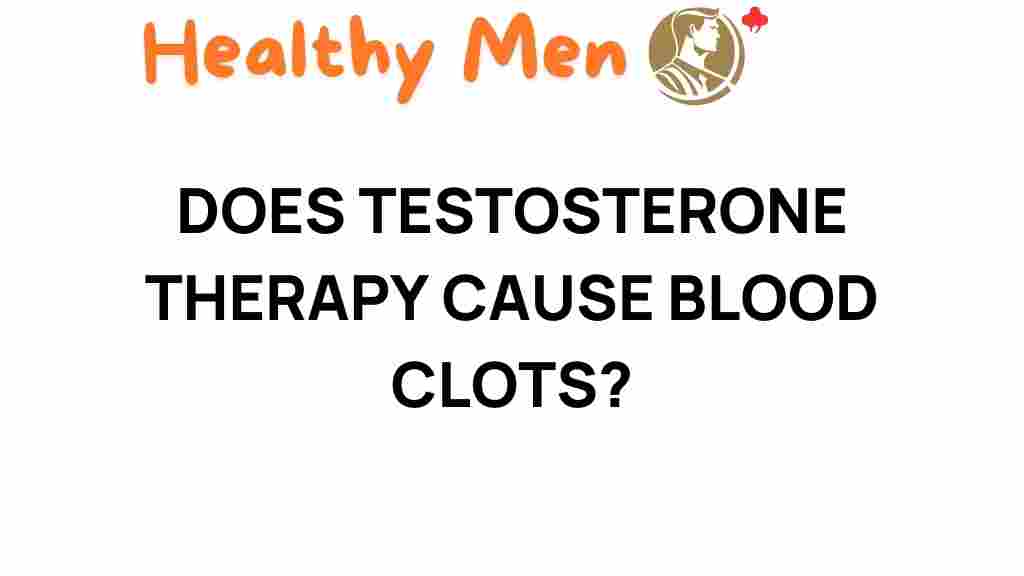Unraveling the Mystery: Does Testosterone Therapy Lead to Blood Clots?
Testosterone therapy has gained popularity in recent years as a treatment for men experiencing low testosterone levels, a condition known as hypogonadism. While many patients report improved energy levels, mood, and libido, concerns about potential health risks, particularly regarding blood clots, have emerged. With increasing attention on hormone treatment and its implications for cardiovascular health, it is imperative to explore the connections between testosterone therapy and thromboembolism.
Understanding the Basics of Testosterone Therapy
Testosterone therapy involves the administration of testosterone through various methods, including injections, patches, gels, or pellets. This therapy aims to restore testosterone levels to a normal range, helping alleviate symptoms associated with low testosterone.
However, as with any medical treatment, it is essential to consider the health risks involved. One of the most pressing concerns among healthcare providers and patients alike is the risk of developing blood clots.
The Link Between Testosterone Therapy and Blood Clots
Several studies have investigated the relationship between testosterone therapy and an increased risk of thromboembolism. Thromboembolism refers to the formation of a blood clot (thrombus) that can travel to other parts of the body, potentially causing serious complications, including deep vein thrombosis (DVT) and pulmonary embolism (PE).
In 2014, a pivotal study published in the journal PLoS One indicated that testosterone therapy might be associated with a higher risk of cardiovascular events, including blood clots. This finding sparked widespread debate and further research into the safety of testosterone treatments.
What Medical Research Tells Us
Numerous research studies have yielded mixed results regarding the safety of testosterone therapy:
- Increased Risk in Older Men: Some studies suggest that older men undergoing testosterone therapy may have an elevated risk of thromboembolism, particularly if they have pre-existing cardiovascular conditions.
- No Significant Risk: Conversely, other research has found no substantial evidence linking testosterone therapy to increased rates of blood clots in younger men or those without cardiovascular issues.
- Meta-Analyses: A comprehensive meta-analysis found that while testosterone therapy might be associated with a slight increase in cardiovascular events, the overall risk of thromboembolism remains low for most patients.
Factors Influencing the Risk of Blood Clots
Several factors can influence the likelihood of developing blood clots while undergoing testosterone therapy:
- Age: Older individuals and those with a history of clotting disorders may be at greater risk.
- Pre-existing Conditions: Patients with obesity, diabetes, or heart disease should be closely monitored during treatment.
- Type of Therapy: Different methods of testosterone administration may have varying effects on cardiovascular health.
Patient Safety: What to Consider Before Starting Therapy
Before embarking on testosterone therapy, patients should consider the following:
- Consult a Healthcare Provider: Discuss your medical history, including any previous clotting issues and cardiovascular health.
- Regular Monitoring: Patients undergoing testosterone therapy should be regularly monitored for blood pressure, hematocrit levels, and any symptoms of thromboembolism.
- Lifestyle Modifications: Maintaining a healthy lifestyle, including regular exercise and a balanced diet, can mitigate some risks associated with testosterone therapy.
Signs and Symptoms of Blood Clots
Recognizing the signs of blood clots is crucial for early intervention. Symptoms may include:
- Swelling: Unexplained swelling in one leg or arm.
- Pain: Pain or tenderness in the affected limb, often described as a cramp or soreness.
- Red or Discolored Skin: Changes in skin color in the affected area.
- Shortness of Breath: Sudden difficulty breathing or chest pain may indicate a pulmonary embolism.
Step-by-Step Process for Safe Testosterone Therapy
To ensure patient safety when considering testosterone therapy, follow these steps:
- Initial Consultation: Schedule an appointment with a healthcare provider to discuss symptoms and possible benefits of testosterone therapy.
- Comprehensive Evaluation: Undergo blood tests to evaluate testosterone levels and assess overall health.
- Discuss Risks: Engage in a thorough discussion about potential risks, including blood clots, and any personal health concerns.
- Choose a Treatment Method: Work with your provider to determine the best method of testosterone administration based on your preferences and health status.
- Regular Follow-Up Appointments: Schedule routine follow-ups to monitor hormone levels and assess for any adverse effects.
- Report Any Symptoms: Promptly report any unusual symptoms, such as swelling or pain, to your healthcare provider.
Troubleshooting Tips for Patients on Testosterone Therapy
If you are currently undergoing testosterone therapy, consider these troubleshooting tips to enhance your safety:
- Maintain a Healthy Weight: Obesity can increase the risk of blood clots; strive for a healthy weight through diet and exercise.
- Avoid Smoking: Smoking is a significant risk factor for clot formation; quitting can improve your overall health.
- Stay Hydrated: Dehydration can contribute to blood clot risk; ensure adequate fluid intake.
- Be Cautious with Medications: Discuss any other medications with your provider, as some can increase clotting risk.
Conclusion: Making Informed Decisions About Testosterone Therapy
The question of whether testosterone therapy leads to blood clots is complex and multifaceted. While some studies indicate a potential risk, the overall findings are mixed, emphasizing the need for individualized assessment.
For many men, the benefits of testosterone therapy may outweigh the risks when managed correctly. It is essential to engage in open communication with healthcare providers, adhere to monitoring protocols, and adopt a healthy lifestyle to enhance patient safety.
As research continues to evolve, staying informed through credible sources and professional guidance will be crucial for those considering hormone treatment. For further information on testosterone therapy and its impacts, you can explore Mayo Clinic’s resources on the subject.
Ultimately, the decision to pursue testosterone therapy should be made with careful consideration of all factors, including potential health risks, to ensure optimal cardiovascular health and overall well-being.
This article is in the category Conditions and created by healthymen Team
